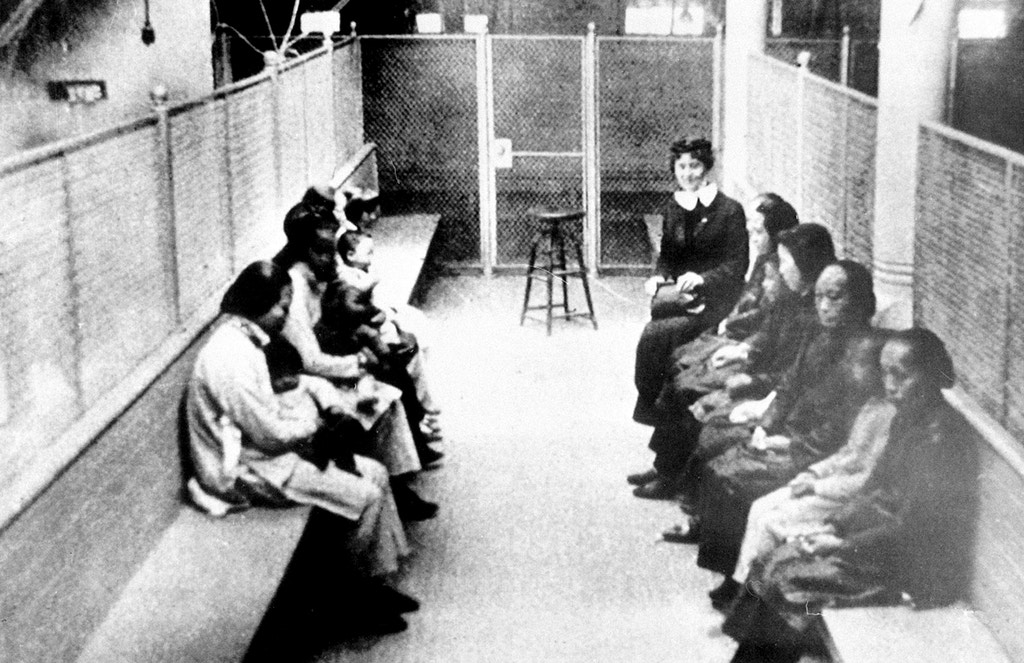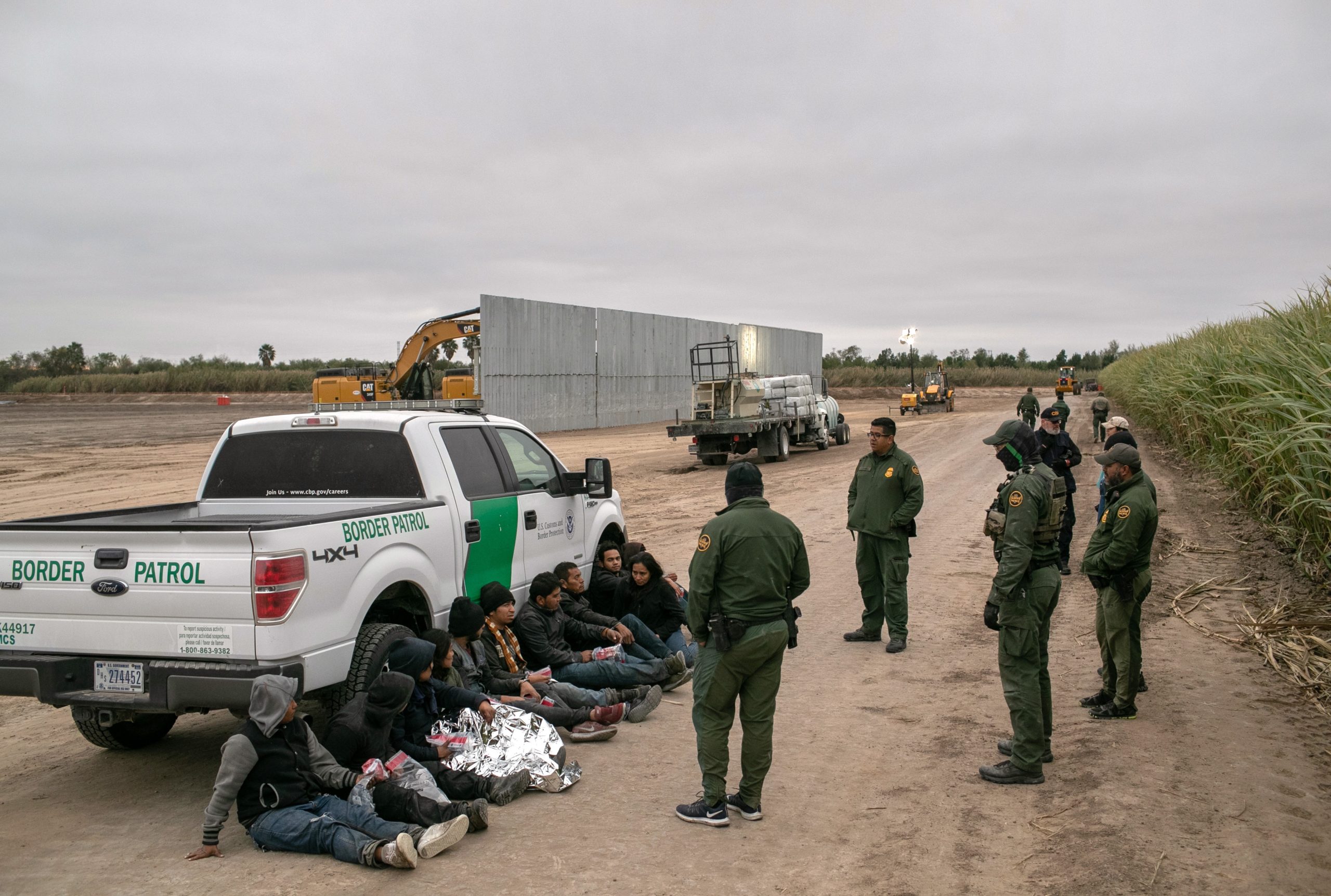Castro’s proposal to repeal 1325 might have seemed to come out of left field, but it’s the exercise of the law that is historically the outlier: While laws criminalizing entry have existed since 1929, they “were largely ignored for a century,” the lawyer and scholar César Cuauhtémoc García Hernández reminds us in a new book, “Migrating to Prison: American’s Obsession with Locking Up Immigrants.” In 1975, he noted “a mere 575 people” were charged with an immigration crime; in 1993, only 2,487. Contrast that with fiscal year 2018, when prosecutors brought 105,692 federal immigration charges.
Image: Courtesy of The New Press
Hernández lays out in a lucid, linear fashion the evolution of immigration law and its enforcement in the United States, from laws restricting the movement of certain people across state lines — formerly enslaved people, for instance — to the Chinese Exclusion Act of 1882, the first in a series of acts that barred Asian immigrants for decades.
Any history of how the notion of “illegality” in migration took root has to consider the experience of Mexicans. While the first U.S. immigration laws focused with explicit racism on excluding Asians, Mexicans were the ones often physically targeted by Border Patrol — harassed, removed, or allowed to pass to satisfy the desires of powerful Southwest planters. In Hernández’s words, Border Patrol “detained and deported their way to a scared workforce.” Many of those workers, whether unauthorized or sanctioned under the bracero program, which ran from 1942 to 1964, were rendered “illegal” by the 1965 Immigration and Nationality Act, which got rid of national quotas and more or less established the United States’ current immigration regime, wherein countries are allotted a certain number of visas. Though ostensibly a progressive measure doing away with the racist quotas and nationality bans of previous eras, when it came to Mexico, the act, also known as Hart-Celler, ignored the closeness of the nations and subjected Mexicans to a national cap nowhere near high enough to accommodate traditional migration levels. “Perversely, the Hart-Celler Act’s formal equality turned immigration law against Mexican migrants,” Hernández writes. Mexicans became “illegal,” and “illegal aliens” became racially coded as Mexican.
Yet it was a relatively brief experiment. By 1954, under Dwight D. Eisenhower, Immigration and Naturalization Service (the precursor to today’s immigration agencies) “had all but abandoned its detention policy.” Ellis Island shut down with little fanfare. Hernández concludes that, “in fact if not in law, the United States came remarkably close to abolishing immigration imprisonment.” While that was, in the words of the attorney general at the time, a step in the direction of “humane administration of the immigration laws,” it was also self-interested, Hernández notes. Immigration prisons were costly, and, as has been the case throughout U.S. history, businesses wanted migrants out of prison so they could be used as cheap labor.

A group of Chinese and Japanese women and children wait to be processed in a wire mesh enclosure at the Angel Island Internment barracks in San Francisco Bay in the late 1920s. The Angel Island Immigration Station processed one million immigrants from 1910 to 1940, mostly from China and Japan.
Photo: AP
In the 1980s and ’90s, legislation introduced new levels of criminality for immigrants, which in turn expanded the population of imprisoned people. As Hernández writes, “Congress denied immigration judges the discretion to release anyone convicted of an aggravated felony,” which includes serious offenses like murder but also shoplifting and tax fraud. Detention and deportation, once decided with considerable discretion, became mandatory for all sorts of offenses. The link between mass incarceration and immigrant incarceration is clear in the legislative history: The same 1986 law that created mandatory minimum sentences for crack cocaine created “detainers,” requests to local police to hold someone in jail until they can be picked up by immigration. Liberals were complicit too. As Grandin notes, Bill Clinton played a key role, signing “a number of extremely punitive crime, terrorism, and immigration bills into law, which created the deportation regime that exists today.”
Muslims and other immigrants from majority-Muslim countries suffered the racist expansion of immigration detention after September 11, 2001, as counterterrorism enveloped immigration into the ballooning national security apparatus. And, as with the incarceration of U.S. citizens, black migrants have been disproportionately impacted by the shift to “crimmigration,” as scholars call it — more likely to be detained for a crime, and more likely to be removed.
Considering the recent explosion in immigration detention, Hernández explores federal contracts with local law enforcement and private prison companies. He looks not just at U.S. Immigration and Customs Enforcement but also the U.S. Marshals Service, which holds some 60,000 people a day in pre-trial detention, making deals with state and local jails around the country (the deaths of immigrants in Marshals custody were recently investigated by Seth Freed Wessler for Mother Jones). Again, the degree to which immigration offenses dominate the criminal justice system is stark — in 2013, marshals detained 97,982 people on immigration crimes, compared with 28,323 drug defendants. The Office of Refugee Resettlement, under the Department of Health and Human Services, had 49,000 children in custody in 2018, in “shelters” that range in comforts offered but which are all tightly controlled. Whatever agency officially holds them, Hernández argues, “to the migrants who are under constant surveillance and whose liberty has been denied there is little difference.”
Detention is also used with the idea that it will dissuade people from coming. Although Hernández points out this is legally suspect — detention of asylum-seekers and people accused of other non-criminal immigration offenses is not supposed to be a punishment — multiple administrations have invoked deterrence as a reason to keep people locked up.

Photo: John Moore/Getty Images
Daniel Denvir’s forthcoming book, “All American Nativism: How the Bipartisan War on Immigrants Explains Politics as We Know It,” complements Hernández’s by focusing on political history. He, too, traces the development of anti-immigrant sentiments and policies alongside anti-black ones, arguing that “resistance to desegregation, a white identity politics of racial grievance, mass incarceration, the war on terror: all were dedicated to a quixotic mission to keep dangerous others from crossing U.S. borders and to restrict the free movement of those inside them.”
Democrats likewise fell into the trap of demonizing “illegal immigrants” and “criminal aliens,” believing that by doing so they could protect legal immigration from hard-right restrictionists and defend themselves from soft-on-crime accusations (just as they’d attempted to do by jumping on the war-on-drugs bandwagon).

Image: Courtesy of Verso Books
The bipartisan embrace of immigration enforcement, Denvir argues, was the product of the elusive quest for so-called comprehensive immigration reform, which would combine a path to legalization for people already in the country with the liberalization of legal immigration — goals sought by immigrant rights groups and big business alike. In order to get it, Democrats and some Republicans, from Clinton through Bush and Obama, tried to appease nativists with promises of “border security,” miles of fencing, massive increases in the Border Patrol, and surveillance systems befitting a war zone. Each time, however, the nativists were not, in fact, appeased, crying “amnesty” and sabotaging the prospect of reform. “The long-term advantage,” of focusing on enforcement, Denvir writes, “would accrue to the Right, which was better positioned to link the immigrant threat to crime, welfare, black people and terrorism.” Trump’s attempt to demand funding for his pet wall in order to save the Deferred Action for Childhood Arrivals, or DACA, program last year, was a repeat of the same pattern. In the end, Trump plowed ahead with construction (literally, through delicate desert ecosystems), and DACA’s fate remains unsettled.
Over time, the left flank of immigration activism has grown wary of both comprehensive immigration reform (finding those “reforms” incremental) and the attempt to distinguish “good” immigrants from “bad” ones. As Denvir notes, “lots of ‘good’ immigrants were being deported too. And how bad were the bad ones, given the vast number of individuals convicted of crimes in the carceral state?”
Hernández ends his book with the case for abolishing immigration detention, while admitting that few people have a specific vision for how to do it. Denvir ends with an analysis of an electorate that might be willing to try. As he puts it, “record deportations and a radicalizing racist right has triggered a revolt among the Democratic Party’s increasingly young and diverse base,” and Democrats under Trump have become “staunchly pro-immigrant” and “more hostile to enforcement.” Hernández also decides to see Trump’s hostility to immigrants not just as horror but also as opportunity. Has the bipartisan consensus of “immigration is a ‘problem’ that needs fixing” finally broken? Will Trump’s nativist wish list of anti-immigrant, anti-refugee policies permanently shift Democrats away from their position that enforcement is always necessary?
Decriminalization of entry and reentry is a start, as Denvir and Hernández advocate (among the remaining Democratic presidential candidates, Bernie Sanders, Elizabeth Warren, Pete Buttigieg, Cory Booker, and Andrew Yang have said they agree). Denvir also calls for downsizing the Border Patrol, destroying existing physical barriers, breaking up agreements between ICE and local law enforcement, and increasing opportunities for legal immigration, especially from Central America and Mexico. Hernández urges, on a personal and institutional level, divestment from private prison companies. Eliminating cash bail and giving every migrant the right to a lawyer would drastically increase their odds of success, as would case management — offering help with housing and legal assistance.
These types of measures might actually lead to better compliance with immigration law, satisfying the obsession with people migrating “the right way.” But they would not offer concessions to a nativist right that wants any and all nonwhite immigration restricted, and they would have to resist the scare tactics bent on tying immigrants to crime and the rhetoric of scarcity that will inevitably accompany an economic downturn and worsening climate conditions. The court cases challenging the most horrendous aspects of confinement in immigrant detention centers are important. But if radical changes come, Hernández writes, “it won’t be because the law demands it. It will be because people demand it.”
Cora Currier | Radio Free (2019-12-28T12:00:10+00:00) Immigration Detention Is Part of Mass Incarceration: The Case for Abolishing ICE and Everything Else. Retrieved from https://www.radiofree.org/2019/12/28/immigration-detention-is-part-of-mass-incarceration-the-case-for-abolishing-ice-and-everything-else/
Please log in to upload a file.
There are no updates yet.
Click the Upload button above to add an update.
